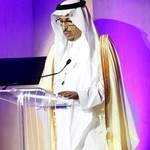 Prince Saud bin Abdullah bin Thenayan Al-Saud, Chairman of SABIC and the Royal Commission for Jubail and Yanbu, announced in Riyadh today that SABIC is in the last stages of preliminary studies for the construction of the world’s first Oil-to-Chemicals (OTC) complex in Saudi Arabia.
Prince Saud bin Abdullah bin Thenayan Al-Saud, Chairman of SABIC and the Royal Commission for Jubail and Yanbu, announced in Riyadh today that SABIC is in the last stages of preliminary studies for the construction of the world’s first Oil-to-Chemicals (OTC) complex in Saudi Arabia.
Prince Saud made this announcement as he inaugurated the SABIC Innovation Day. He said that the Innovation Day is a showcase of SABIC’s technological achievements around the world. “Saudi Arabia is on a journey to grow, diversify itself, reduce its energy intensity and move towards a knowledge economy. To this end, it requires the commitment and effective execution of all its engines. Today we will demonstrate how SABIC is well on the way to transforming itself into a solutions provider to its destination markets and delivering value to its customers via technology. All of this means innovation, which is commercialized invention.”
Mohamed Al-Mady, SABIC Vice Chairman and CEO, welcomed key external stakeholders, including government officials, key SABIC customers, businessmen, academicians, research partners, and media representatives. Notable speakers included: Professor Vijay Govindarajan, Coxe Distinguished Professor at Tuck at Dartmouth; Professor Jean-Lou Chameau, President of King Abdullah University of Science and Technology (KAUST); and Dr. Mohammad Al-Suwaiyel, President, King Abdulaziz City for Science and Technology (KACST).
In his keynote address, Al-Mady said, “SABIC is today seeing the rewards of innovation leadership and driving the technology agenda in key areas of our business. The OTC complex will set a new competitive standard and establish Saudi Arabia as a technology leader in the petrochemical industry. OTC technology allows for the conversion of crude oil to petrochemical products at the highest ever achieved conversion rate in a competitive and sustainable way.”
The OTC complex will comprise an innovative configuration of unit operations that, in combination, will generate the world’s highest yield conversion of oil to chemicals. SABIC expects to utilize around 10 million metric tons of crude oil at the complex to produce petrochemicals, and eventually advanced specialty chemicals in line with SABIC’s 2025 strategy.
The complex is expected to start up by the end of the current decade and will provide an aggregated total of around 100,000 new jobs, according to current company projections. The project comes at a time when the company is focussing strongly on research and innovation to produce new materials to face global market challenges.
To help spur innovation globally, Al-Mady announced an annual Innovation Award to entrepreneurs. SABIC is offering cash awards of up to SR 10 million along with research and commercial support for innovative ideas or existing inventions in the field of smart polymers. Applications will be accepted electronically through the SABIC website from June 1, 2014.
“Every year SABIC screens more than 250 start-ups for possible partnership,” said Al-Mady. “We hope the SABIC Innovation Award will encourage many more worthy projects.”
“SABIC’s innovation engine is firing on all cylinders,” he told the attendees. “Innovation is key to the future not only of SABIC but more broadly for our country. Innovation can make Saudi Arabia a knowledge economy and a more energy efficient environment. But it takes the continued efforts of government, academia and business to generate an ecosystem for growth. We are and will continue to be part of those efforts.”
Also speaking on the occasion, Ernesto Occhiello, SABIC Executive Vice President, Technology and Innovation, said that SABIC recently filed for its 10,000th patent, a landmark number that establishes the company as the largest patent developer in the Middle East. On average, SABIC files a new patent every 18 hours, each based on the work of approximately four researchers. This represents greater efficiency than any other top ten companies in the chemical industry, he said.
“Intellectual property is an important tool to help SABIC achieve its 2025 strategy,” he said. “Our patent estate is one of several indicators we use to measure our return on investment in research and development. Our 10,400 global patent dockets are a reflection of our emphasis on innovation to support our growth.”
